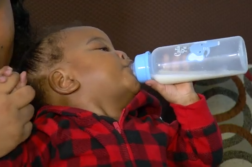STANFORD, Calif. (Ivanhoe Newswire) – Currently, more than 100,000 people in the U.S. are in need of an organ transplant. While it’s considered lucky to be matched once – we’re about to meet a young man who received three organs at three different times in his life. Transplants
Nineteen-year-old Joseph “Joe Joe” Sanchez Munoz lights up whenever he plays his guitar. He wrote a special song telling how he survived three organ transplants.
Joe Joe expresses, “Music was my medicine and it got me through.”
Joe Joe was born with multicystic dysplastic kidney disease, meaning his kidneys were severely underdeveloped. A devastating diagnosis in itself, but shortly afterward his mom, Elena was told that Joe Joe also had liver cancer.
“My whole world was shattered ‘cause I didn’t know what to expect,” Elena painfully recalls.
At just 10 months old, Joe Joe received a liver transplant. Subsequent chemotherapy affected his kidneys and while Joe Joe ultimately received a new kidney, he continued to defy the slim odds and was healthy until this past year. This time, his heart was in jeopardy – a result of being immunocompromised.
Pediatric Advanced Cardiac Therapies Program doctor at Stanford Medicine Children’s Health, Michael Ma, MD says, “Most programs would say that the risk is too high and not offer this much therapy to allow a young child to survive.”
And so, Dr. Ma and his team of cardiologists worked alongside liver and kidney specialists to a map out a plan to save Joe Joe’s life.
“They allowed him to have a third miracle of life,” Elena expresses.
Dr. Ma explains, “He is now in remission from heart, liver, and kidney disease, and is doing really well.”
“Thank you so much for helping me,” Joe Joe says to Stanford.
Joe Joe is so appreciative of the care he received through the years at Stanford that he wants to pay it forward – he’s now considering entering the nursing field, like his mom.
Contributors to this news report include: Jennifer Winter, Producer; Joe Alexander Short, Videographer; Roque Correa, Editor.
To receive a free weekly e-mail on medical breakthroughs from Ivanhoe, sign up at: http://www.ivanhoe.com/ftk
Source:
Donate Life America
MEDICAL BREAKTHROUGHS
RESEARCH SUMMARY
TOPIC: YOUNG MAN RECEIVES THE RARE GIFT OF THREE TRANSPLANTS
REPORT: MB #5337
BACKGROUND: Organ transplantation is a medical procedure that involves replacing a damaged or failing organ in a person’s body with a healthy organ from a donor. This life-saving procedure has significantly advanced over the years, offering hope to individuals suffering from organ failure due to various reasons, such as diseases, accidents, or congenital conditions. Currently, over one hundred thousand people in the United States are in need of an organ transplant. Several experts will help you prepare for a transplant procedure before it takes place to ensure comfort before, during, and after the surgery. There are two different kinds of transplants. An autologous transplant, one that uses your own bone marrow, and an allogeneic transplant, one that uses a donor’s bone marrow.
DIAGNOSING: Diagnosing the success or complications of an organ transplant involves a comprehensive and multidisciplinary approach, combining clinical assessments, imaging studies, and laboratory tests. The primary goal is to monitor the function of the transplanted organ, detect signs of rejection or complications, and ensure the overall well-being of the transplant recipient. The key aspects of diagnosing the need for a transplant are a clinical evaluation involving patient history and a physical examination, laboratory tests such as blood tests and biopsies, imaging studies, functional testing, and psychological assessments.
NEW TECHNOLOGY: Recent advances in the medical field such as treating infections like hepatitis C and HIV are making previously unusable organs now usable. Technology is now making it possible for organs to maintain viability for longer periods of time outside of the body before a transplant takes place and even allows them to improve their quality.
FOR MORE INFORMATION ON THIS REPORT, PLEASE CONTACT:
Katie Chen
If this story or any other Ivanhoe story has impacted your life or prompted you or someone you know to seek or change treatments, please let us know by contacting Marjorie Bekaert Thomas at mthomas@ivanhoe.com



